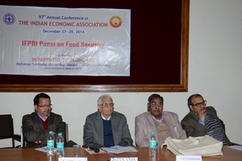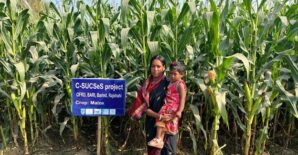Konark Sikka is an intern with IFPRI- South Asia office

Participants at the Conference in Udaipur
Despite being self-sufficient in food production, access and distribution of food pose a major challenge for the food security of the country. An efficient public distribution system goes a long way in moving surplus to regions with demand, thus avoiding wastage of resources and working towards food security.
IFPRI’s, Research Fellow Dr. Anjani Kumar gave a presentation on the Public Distribution System (PDS) in India, at the 97th Annual Conference of Indian Economic Association recently. He talked about the PDS system and how it effects poverty alleviation and food security.
In order for the National Food Security Act to be a success, a strong PDS is crucial. From the National Sample Survey Organization, the data regarding production, consumption and nourishment values of food were analyzed. It was found that the percentage of population which was undernourished had fallen across both rural and urban lines, as well as along the dimensions of calories, proteins and fats. Meanwhile, over the past 20 years, there had been an increase in the extension and outreach of the PDS across states. Furthermore, in the last 20 years, the access to the PDS by SC, ST, OBC and other disadvantaged groups have significantly increased.
Statistics collected also show a general increase in income transfer in the last two decades. . This clearly seems to have a positive impact on poverty alleviation, since projections of poverty, with and without the PDS, show a slash in poverty rates in the scenario with the PDS. These projections when applied to different groups show the same as well. For instance, amongst people below the poverty line. Projections for calorie deficient populations yield a similar result.
In conclusion, an analysis of data and statistics over the past decades shows an impact of the PDS in cutting down poverty numbers and improving food security. This impact cut across rural and urban lines and across disadvantaged groups as well. Furthermore, the scope and reach of the PDS also increased in this timeframe. The author’s recommendation is that the PDS should not be ignored or sidelined, but given a major role in achieving food security and poverty alleviation in the future.


